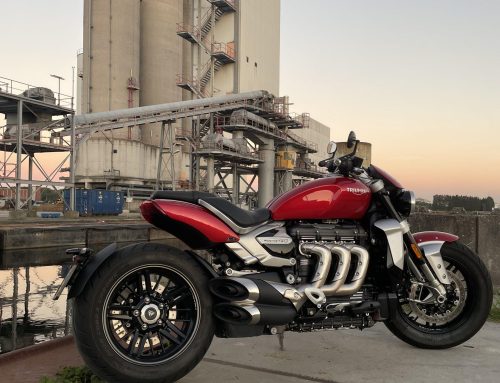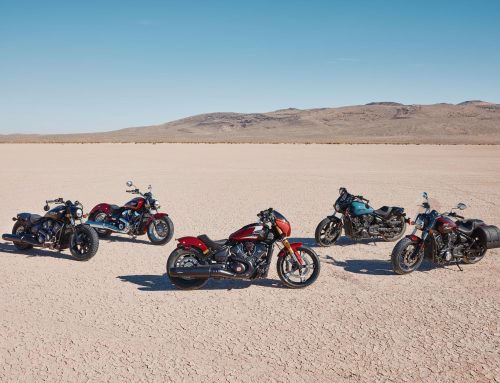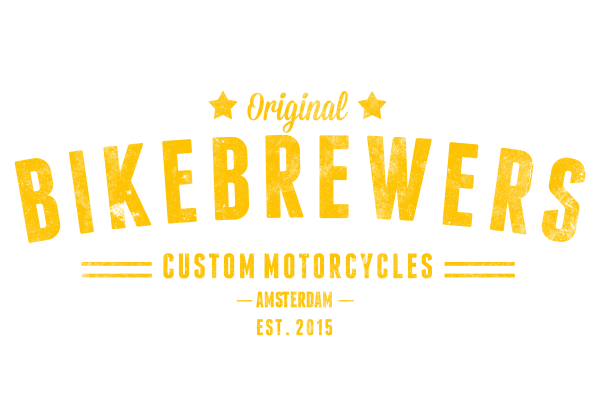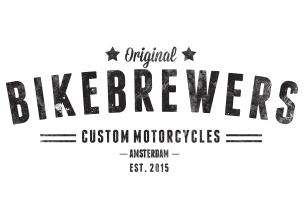
Custom bikes are always at the center of BikeBrewers’ attention. But almost every custom art piece spawns from something that was produced by a motorcycle manufacturer. We feel it is only right to occasionally highlight new models we consider to be cool enough to be seen among all those magnificent custom dreams. The bikes we select all have a great potential for customization, bringing us back to our roots. In this editorial piece, our Spanish Brewer Thierry Tronquit Prats zooms in on an American heavyweight: the Indian Springfield
Abundance in everything
Just recently, I had the opportunity to test ride the 2020 Indian Springfield, a classic old-school bagger. This bike is a true powerhouse with Indian’s largest production engine prior to 2020. Its thumping heart is an 1800cc V-twin engine, well endowed with lots of torque. The machine is adorned with lots of chrome and other frilly stuff.
But before talking about this custom cruiser, let’s review the heritage of this iconic American motorcycle brand. Did you know that the Indian Motorcycle Company was responsible for some of the earliest advancements in motorcycle technology and some impressive early motorcycle speed records?
In 1901, Hendee hired Oscar Hedstrom to create a gas-powered bike that could pace bicycle races. Following the success and excitement around this first machine, the company opened a factory in Massachusetts and began mass-producing motorcycles. In their first year on the market, a rider on an Indian motorcycle won a race from Boston to New York. In 1903, the Indian Motorcycle Company was on its way to becoming the largest and most important motorcycle manufacturer in the world. That same year, a couple of young men in Milwaukee built the very first Harley-Davidson motorcycle, creating what would become Indian’s biggest rival.
Win on Sunday, sell on Monday
In 1906, a pair of riders used an Indian motorcycle to ride from San Francisco to New York in a record-setting 31.5 days. In the 1910’s Indian Motorcycles were re-engineered with a modern suspension system, the first electric starter on a motorcycle and a whopping 1000cc engine. All of these upgrades helped Indian motorcycles break even more both speed records and endurance records. In 1911, Indian dominated the world of racing, winning the most prestigious race of them all, the Isle of Man Senior Trophy. By the end of that year, Indian motorcycles had set no less than 121 recognized racing records.
Throughout the first part of the 1900s, Indian produced high performance models (the first Indian Scout in 1920, the Indian Chief in ‘22 and the Big Chief in 1923) and was always ahead of its time improving the engine and frames. Indian managed to solidify itself in the history of motorcycling through road racing, dirt racing and land speed attempts on the world-famous Bonneville Salt Flats throughout the 20th Century. Indian also established itself in the world of flat track, leading it to become rivals with Harley-Davidson.
Rising from the ashes
However, in 1953, due to a lack of sales and the effect of the WWII, Indian Motorcycles ceased operations. The brand name and rights changed hands a few times from 1953 until 1977. It was only in 2011 that Indian made a strong come-back when Polaris Industries purchased the brand. 2013 marked the big unveiling of the rejuvenated Indian Motorcycle. The awesome Thunder Stroke 111 V-Twin engine was introduced and a new generation of bikes was unveiled. The Indian Motorcycle has been reinvented with new models released over the last 7 years including the Indian Roadmaster, all-new Indian Scout, the flat tracker inspired FTR, the Indian Chief Dark Horse and the Springfield.
Springfield
The Indian Springfield hit the market in 2016 and its design has been carried over into the 2020 model year due to its success.
With a combination of power from the powerful ‘Thunderstroke’ 111 V-twin (119Lb-Ft @ 3,000RPM), world-class engineering and premium touring features, the Indian Springfield is built for the long haul. The valenced fender, introduced in 1940 and used through 1942, leads the way with a chrome brow and iconic, lighted war-bonnet crest. Chrome beer-can fork skirts beef up the stems, as does the headlight nacelle and whisker bar, and the latter supports a pair of passing lamps along with the front turn signals to wrap up the forward lighting. A true American icon! Much like the early American tour bikes, the Springfield pushes a large, quick-release windshield that leaves you with the similar level of protection as a true fairing but with much greater visibility forward and down. In my case, because of my height, it generated turbulence around the helmet. From what I know, a higher screen is available.
A chrome instrument panel rides on the 20.8L fuel tank with the on/off button, a round fuel gauge and large analog gauge for the speedometer. A host of indicator lights are set in the face of the speedo, and there’s a small LED screen to handle the remaining metrics and act as an interface for the Ride Modes feature. Standard features are 3 ride modes and rear cylinder deactivation. The Indian Springfield maintains rider-favourite features such as the genuine leather seats, remote-locking saddlebags and adjustable passenger floorboards. ABS, cruise control, key-less ignition and tire pressure monitoring also come standard.
Regarding the frame, a cast-aluminum skeleton holds it all together, and while that undoubtedly removes some weight, it still tips the scales at 376kg wet. It’s not at all what you’d call a ‘lightweight’ bike and not ideal for urban riding and zigzagging through rush hour traffic. It’s heavy and the deactivation / activation of the cylinder is quirky when you take off at a green light.
One area that I could see some improvement is the rear ABS. A slam on the rear brake pedal will still result in a tire lock and that is not good when you are riding in the city on a winter day. Trust me, I know what I am talking about.
Open road, here we come!
But once you set it free on open roads, you will discover an incredibly smooth and stable ride. The Springfield has stump-pulling torque way down low delivered to the back wheels by a belt drive and six-speed transmission. The seat is very comfortable and the riding position is perfectly upright. If lower speeds are all you need, the Springfield might just be the bike for you. If, like me, you like the cruiser style but also enjoy bombing through some twisties, the Springfield will do both of these quite well, better than the equivalent Harley Davidson Street Glide, in my personal opinion.
The 2020 Indian Springfield is a touring cruiser that is designed to both be modern in comfort and technology, but classic in terms of looks and feel.
Share This Story, Choose Your Platform!
Tags

Custom bikes are always at the center of BikeBrewers’ attention. But almost every custom art piece spawns from something that was produced by a motorcycle manufacturer. We feel it is only right to occasionally highlight new models we consider to be cool enough to be seen among all those magnificent custom dreams. The bikes we select all have a great potential for customization, bringing us back to our roots. In this editorial piece, our Spanish Brewer Thierry Tronquit Prats zooms in on an American heavyweight: the Indian Springfield
Abundance in everything
Just recently, I had the opportunity to test ride the 2020 Indian Springfield, a classic old-school bagger. This bike is a true powerhouse with Indian’s largest production engine prior to 2020. Its thumping heart is an 1800cc V-twin engine, well endowed with lots of torque. The machine is adorned with lots of chrome and other frilly stuff.
But before talking about this custom cruiser, let’s review the heritage of this iconic American motorcycle brand. Did you know that the Indian Motorcycle Company was responsible for some of the earliest advancements in motorcycle technology and some impressive early motorcycle speed records?
In 1901, Hendee hired Oscar Hedstrom to create a gas-powered bike that could pace bicycle races. Following the success and excitement around this first machine, the company opened a factory in Massachusetts and began mass-producing motorcycles. In their first year on the market, a rider on an Indian motorcycle won a race from Boston to New York. In 1903, the Indian Motorcycle Company was on its way to becoming the largest and most important motorcycle manufacturer in the world. That same year, a couple of young men in Milwaukee built the very first Harley-Davidson motorcycle, creating what would become Indian’s biggest rival.
Win on Sunday, sell on Monday
In 1906, a pair of riders used an Indian motorcycle to ride from San Francisco to New York in a record-setting 31.5 days. In the 1910’s Indian Motorcycles were re-engineered with a modern suspension system, the first electric starter on a motorcycle and a whopping 1000cc engine. All of these upgrades helped Indian motorcycles break even more both speed records and endurance records. In 1911, Indian dominated the world of racing, winning the most prestigious race of them all, the Isle of Man Senior Trophy. By the end of that year, Indian motorcycles had set no less than 121 recognized racing records.
Throughout the first part of the 1900s, Indian produced high performance models (the first Indian Scout in 1920, the Indian Chief in ‘22 and the Big Chief in 1923) and was always ahead of its time improving the engine and frames. Indian managed to solidify itself in the history of motorcycling through road racing, dirt racing and land speed attempts on the world-famous Bonneville Salt Flats throughout the 20th Century. Indian also established itself in the world of flat track, leading it to become rivals with Harley-Davidson.
Rising from the ashes
However, in 1953, due to a lack of sales and the effect of the WWII, Indian Motorcycles ceased operations. The brand name and rights changed hands a few times from 1953 until 1977. It was only in 2011 that Indian made a strong come-back when Polaris Industries purchased the brand. 2013 marked the big unveiling of the rejuvenated Indian Motorcycle. The awesome Thunder Stroke 111 V-Twin engine was introduced and a new generation of bikes was unveiled. The Indian Motorcycle has been reinvented with new models released over the last 7 years including the Indian Roadmaster, all-new Indian Scout, the flat tracker inspired FTR, the Indian Chief Dark Horse and the Springfield.
Springfield
The Indian Springfield hit the market in 2016 and its design has been carried over into the 2020 model year due to its success.
With a combination of power from the powerful ‘Thunderstroke’ 111 V-twin (119Lb-Ft @ 3,000RPM), world-class engineering and premium touring features, the Indian Springfield is built for the long haul. The valenced fender, introduced in 1940 and used through 1942, leads the way with a chrome brow and iconic, lighted war-bonnet crest. Chrome beer-can fork skirts beef up the stems, as does the headlight nacelle and whisker bar, and the latter supports a pair of passing lamps along with the front turn signals to wrap up the forward lighting. A true American icon! Much like the early American tour bikes, the Springfield pushes a large, quick-release windshield that leaves you with the similar level of protection as a true fairing but with much greater visibility forward and down. In my case, because of my height, it generated turbulence around the helmet. From what I know, a higher screen is available.
A chrome instrument panel rides on the 20.8L fuel tank with the on/off button, a round fuel gauge and large analog gauge for the speedometer. A host of indicator lights are set in the face of the speedo, and there’s a small LED screen to handle the remaining metrics and act as an interface for the Ride Modes feature. Standard features are 3 ride modes and rear cylinder deactivation. The Indian Springfield maintains rider-favourite features such as the genuine leather seats, remote-locking saddlebags and adjustable passenger floorboards. ABS, cruise control, key-less ignition and tire pressure monitoring also come standard.
Regarding the frame, a cast-aluminum skeleton holds it all together, and while that undoubtedly removes some weight, it still tips the scales at 376kg wet. It’s not at all what you’d call a ‘lightweight’ bike and not ideal for urban riding and zigzagging through rush hour traffic. It’s heavy and the deactivation / activation of the cylinder is quirky when you take off at a green light.
One area that I could see some improvement is the rear ABS. A slam on the rear brake pedal will still result in a tire lock and that is not good when you are riding in the city on a winter day. Trust me, I know what I am talking about.
Open road, here we come!
But once you set it free on open roads, you will discover an incredibly smooth and stable ride. The Springfield has stump-pulling torque way down low delivered to the back wheels by a belt drive and six-speed transmission. The seat is very comfortable and the riding position is perfectly upright. If lower speeds are all you need, the Springfield might just be the bike for you. If, like me, you like the cruiser style but also enjoy bombing through some twisties, the Springfield will do both of these quite well, better than the equivalent Harley Davidson Street Glide, in my personal opinion.
The 2020 Indian Springfield is a touring cruiser that is designed to both be modern in comfort and technology, but classic in terms of looks and feel.












